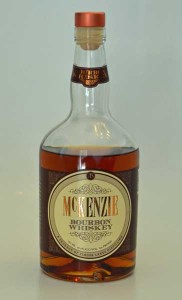McKenzie Bourbon Review
By Richard Thomas
Rating: C+

from Finger Lakes Distillery
(Credit: Richard Thomas)
McKenzie Bourbon Whiskey is a prime example of the spirit of experimentation sweeping American whiskey these days. Made by Finger Lakes Distillery, a small operator nestled into the wine country of upstate New York, McKenzie Bourbon (along with McKenzie Rye) incorporates the two big trends that are changing the face of whiskey-making in the United States.
The first of those trends is small barrel aging, a development that has not gone unmarred by controversy. Briefly, the point of small barrel aging is to increase whiskey exposure to barrel, accelerating the absorption of certain characteristics from the wood. Primary maturation for McKenzie Bourbon is in 10-gallon (as opposed to the traditional 53-gallon) charred, new oak barrels, and lasts for up to 18 months.
The other new trend found in McKenzie Bourbon is finishing. A well-established practice in Scotland, transferring whiskey to a new set of barrels for another, secondary round of aging is relatively new in America. Finger Lakes finishes its bourbon in old chardonnay casks for about four to six weeks.
These two trendy features aside, McKenzie Bourbon has all the other traditional features of a craft whiskey. The grain for the mashbill (70% corn, 20% rye, 10% malted barley) is carefully chosen, with the heirloom corn and rye coming from area farmers. After fermentation, the whiskey is double pot-distilled in equipment made by those master engineers in Holstein, Germany. After the aforementioned, abbreviated aging, the bourbon is bottled at 91 proof (45.5% abv).
The Bourbon*
I must admit that Finger Lakes’ choice of packaging doesn’t look like much. The bottle is just fine: a clear glass, squat, rounded container that does a fine job of showing off the whiskey within. However, the labeling is the sort of thing I might expect from trinkets in an Old West tourist trap. Sitting somewhere in the middle is the faux copper, plastic stopper with artificial cork. Its appearance is something a mixed bag, but don’t let that throw you.
Even so, the best part about the how the whiskey looks is the color. An orangey-amber resembling polished copper, the McKenzie Bourbon manages to be both bright and dark at the same time. The nose is full, but light and crisp, with a scent that is predominately woody, its oaky and vanilla notes trailing off into a slight astringency, and with a noticeable dash of dried fruit.
On the palate, McKenzie Bourbon has a silky texture. The flavors are once again primarily the woody oak, vanilla and caramel, but with a little extra dried fruits sweetness, plus a minor nutty note and a touch of rye spice. The finish has a middling length and a moderate warmth, with the woody notes fading out into a lingering spiciness.
The usual complaint about small barrel aging is that, by doing things quickly, many of the processes of barrel maturation that take place only over the course of years are cut out of the equation, producing an inferior whiskey. Whatever one thinks of that conclusion, Finger Lakes certainly got around it with the chardonnay finish, which undoubtedly took the sophistication of the McKenzie Bourbon up a notch. While not great whiskey, it is a good whiskey, and certainly pleasant enough to satisfy the needs of most any sipper.
The one word of advice I have about the McKenzie Bourbon is to drink it neat. I found adding a splash of water does nothing beyond watering it down. This stuff is fine just the way it is.
The Price
I have seen McKenzie Bourbon listed at around $45, although some vendors price a bottle all the way up to the middle 50s.
* My bottle came from Batch 9 – 2012. There may be some variation between individual batches.




